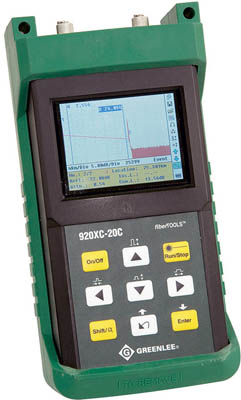
|
|
The Greenlee 920XC-20M 850 / 1300 nm handheld OTDRs can make an assessment of one single optical fiber or a whole optical fiber chain. In addition, the user can directly observe loss and events distribution of an optical fiber chain. The 20XC-20M tools check the transmission quality of optical fiber through the measurement of backscatter. Standard organizations like the International Telecom Union (ITU) define backscatter as an effective analysis means to measure optical fiber loss. Backscattering is also the only effective way of connector inspection, which can be applied to measure the length of optical fiber. The 920XC-20M OTDRs operate by reviewing events in optical fiber (for example, irregularities and connectors). These tools can help identify irregularities in optical fiber, locate them, and measure their attenuation, relevant loss, and homogeneity. These tools are easy-to-use, small, and compact with large LCD displays and graphical interfaces. They can save and transfer the measurement curves data to a PC by using the provided Trace Viewer software for further analyzing, reporting, and printing. Specifications. Wavelength (±20 nm): 850 / 1300. Dynamic Range (db): 18/22. Fiber Type: Multi-mode. Selectable Ranges (km): 0.1/0.3/0.5/1.3/2.5/5/10 (@ 850 nm); 0.1/0.3/0.5/1.3/2.5/5/10/20/40/80 (@ 1300 nm). Pulse Widths (ns): 12/30/100/275/1 µs (@ 850 nm); 30/100/275/1 µs/2 µs (@ 1300 nm). Average Time (s): 15/30/60/120/180. Attenuation Deadzone (m): 20. Event Deadzone (m): 7. Sampling Range (m): 1 to 10. Sampling Points: 16000 (maximum). Distance Measure Accuracy: ± (1 m + 5 x 10-5 x Distance (m) + sampling space). Attenuation Measure Accuracy: 0.05 dB/dB. Reflection Measure Accuracy: ±4 dB. Measurement Data Storage: 1000 test curves. Display Type: Color. Data Transmission RS-232/USB port.
|